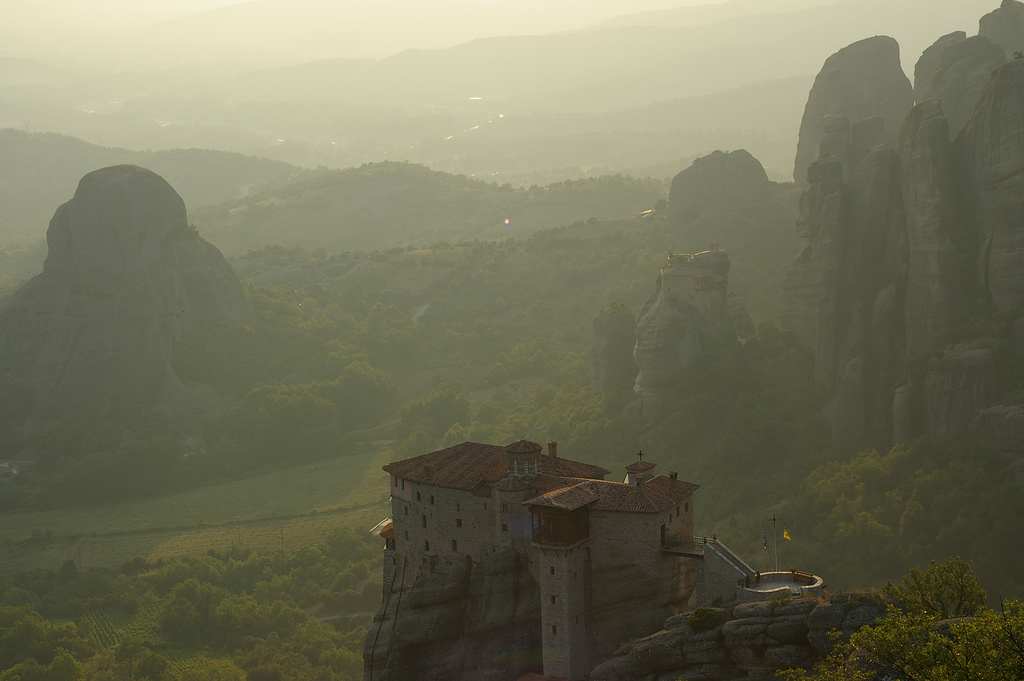

Location: Plain of Thessaly, near Kalambaka Map
Meteora is located in the Northwest corner of the Plain of Thessaly. Meteora (Μετέωρα, Greek for “suspended rocks” or “suspended in the air”) is a complex of 24 monasteries build on top of the sandstone rock pillars of which only six survived to our days. It is second most important and second largest Christian site in Greece, second only to mount Athos. Meteora is a Greek Orthodox religious complex situated near the Greek town of Kalambaka on the Northwestern outskirts of the Thessalian plain. Picturesque rocks of Meteora formed about 60 million years ago. Along with Mount Athos it is one of the most venerated monastic communities. Meteora is derived from the Greek word "meteor" that literally means "floating in the air".
First communities of monks appeared in this northwestern edge of Plain of Thessaly as early as 10th century AD under leadership of a monk Barnabas. Although it is likely that these rocks housed individual hermits much earlier, but they left no records of their presence in the region. Constant raids from enemies forced them to build spectacular monasteries at breath- taking heights. The only way in and out was by climbing rope ladders and wooden scaffolding to various caves and rock pits. The skit (small monastery) Stag (Dupiani) was founded in 1160 which became the "progenitor" of the first Meteora monastic community.
Over the last century the methods for reaching monasteries of Meteora got better with stairs and bridges erected for tourists. Close proximity to towns of Kalampaka and Kastraki makes the site more accessible without having to abandon the civilization.
The Holy Monastery of Great Meteoron is the largest monastery in the religious complex. It was constructed in the middle of the 14th century. It was further increased in size and complexity in 1483 and again in 1552. The main church in this Greek Orthodox monastery is dedicated to the Transfiguration of Jesus (on mount Tabor) in the middle of the 14th century. Its decorations date back to 15th and 16th centuries.
The Holy Monastery of Varlaam (1541) (Meteora)
The Holy
Monastery of Rousanou (mid- 16th century) (Meteora)
The Holy
Monastery of St. Nicholas Anapausas (16th century) (Meteora)
The
Holy Monastery of St. Stephen (16th century) (Meteora)
The
Monastery of Holy Trinity (1475) (Meteora)
Geology
Meteora is located on the northwestern border of the
Thessalian plain and near the southern tip of the Middle Greek
Basin, a tectonic depression that stretches from Albania to
Thessaly. The Middle Greek basin borders on the west with Pindos and
on the east is bordered by the pelagic zone of the Greek women. The
basin is full of sediments carried by rivers or sea sediments. In
the southern part of the basin, where Meteora is located, these
sediments date from the Oligocene and the Neolithic. On them are the
later sediments of the Thessalian plain, which cover the southern
part of the Meteora complex.
The Meteora complex consists
mainly (in a percentage that reaches 95%) of pebbled sandstone and
cobblestone of the Oligocene and Neolithic, and the rest are mainly
coarse sandstones. It also contains a very small percentage of
siltstones, which where present form a thin layer a few centimeters
thick.
The sandstones consist of layers several meters thick,
wedge-shaped. In place between these layers there are lenticular
layers. The sandstone layers have been identified as deposits of an
old Gilbert-type river delta. The delta advanced from east to west.
Channels created notches in the sediments, which can be seen to this
day. These canals were probably created when the area rose or the
sea level dropped. The total thickness of the delta deposits reaches
300 meters. In some places, on the tops of the hills, a layer of
cobblestones is preserved above the layer of sandstones, consisting
of gneisses of the Paleozoic century and marbles of the Triassic
period. This layer is thicker to the northeast. It is believed to
have been created from river deposits.
Meteora today has the
form of steep peaks with a height of up to 200 meters and a width of
up to 300 meters. The average altitude is 313 meters. Inside these
rocks is the Theopetra Cave.